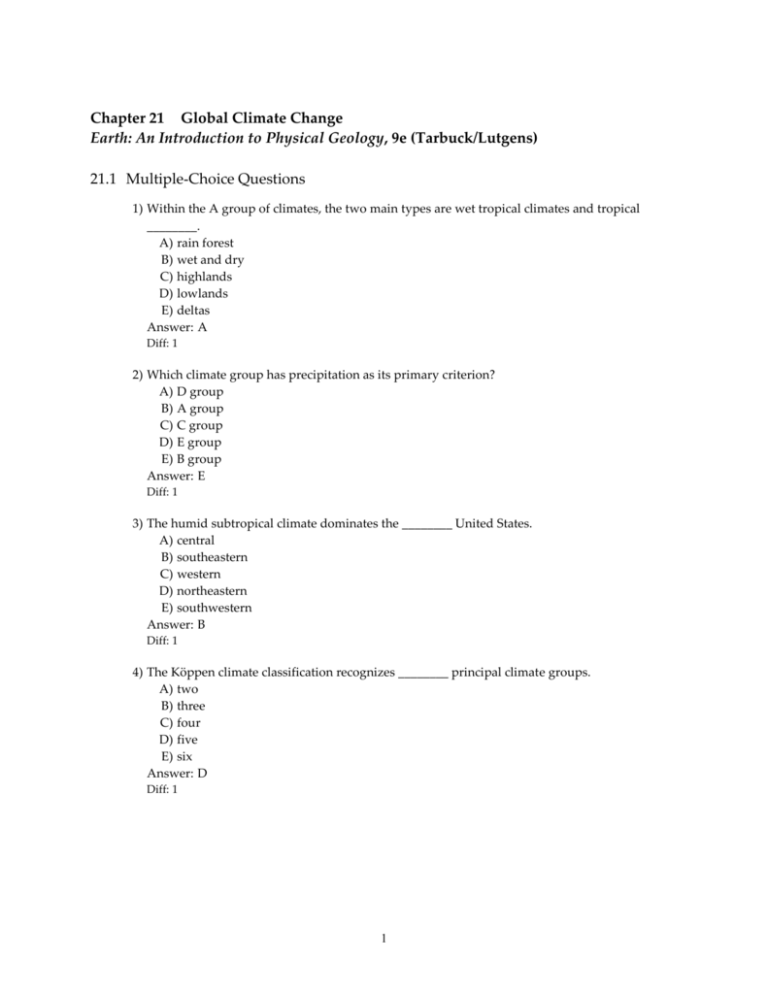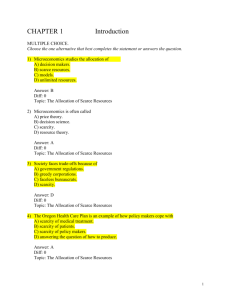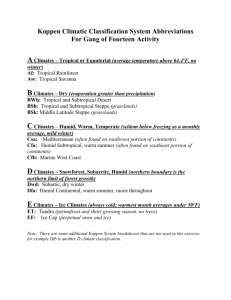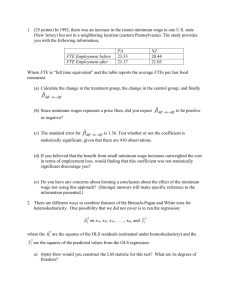Earth,Tests,Ch21
advertisement

Chapter 21 Global Climate Change Earth: An Introduction to Physical Geology, 9e (Tarbuck/Lutgens) 21.1 Multiple-Choice Questions 1) Within the A group of climates, the two main types are wet tropical climates and tropical ________. A) rain forest B) wet and dry C) highlands D) lowlands E) deltas Answer: A Diff: 1 2) Which climate group has precipitation as its primary criterion? A) D group B) A group C) C group D) E group E) B group Answer: E Diff: 1 3) The humid subtropical climate dominates the ________ United States. A) central B) southeastern C) western D) northeastern E) southwestern Answer: B Diff: 1 4) The Köppen climate classification recognizes ________ principal climate groups. A) two B) three C) four D) five E) six Answer: D Diff: 1 1 5) Almost ________ of Australia is desert. A) 10% B) 20% C) 30% D) 40% E) 50% Answer: D Diff: 1 6) In a climatological sense, dryness is a function of both annual rainfall and ________. A) altitude B) solar radiation C) wind direction D) slope E) evaporation Answer: E Diff: 1 7) Which one of the following is NOT a component of the climate system? A) biosphere B) solid Earth C) exosphere D) cryosphere E) hydrosphere Answer: C Diff: 1 8) The name ________ climate is often used as a synonym for the dry-summer subtropical climate. A) Australian B) Indian C) Mediterranean D) African E) European Answer: C Diff: 1 9) The ________ west coast climate is situated on the western (windward) side of continents from about 40 to 65 degrees north and south latitude. A) Mediterranean B) marine C) humid D) continental E) subtropical Answer: B Diff: 1 2 10) The two types of dry (B) climates are desert and ________. A) tundra B) taiga C) steppe D) arid E) highland Answer: C Diff: 1 11) Winterless climates with all months having a mean temperature above 18˚C are known as ________ climates. A) humid tropical B) dry C) polar D) humid middle-latitude Answer: A Diff: 1 12) The climate in which temperatures average 25˚C or more each month and total precipitation for the year is high is the ________ climate. A) marine west coast B) humid subtropics C) humid continental D) wet tropics E) highland Answer: D Diff: 1 13) The ________ climates are land-controlled climates, the result of broad continents in the middle latitudes. A) A B) B C) C D) D E) E Answer: D Diff: 1 14) The ________ sides of mountains are often wet. A) leeward B) sunny C) windward D) steep E) southern Answer: C Diff: 1 3 15) Which one of the following is NOT a trace gas contributing to a future global increase in temperature? A) nitrous oxide B) methane C) water vapor D) chlorofluorocarbons Answer: C Diff: 1 16) For more than 70 years, the best-known and most used climate classification system has been the ________ classification. A) Klingel B) Köppen C) Smith D) Hutton Answer: B Diff: 1 17) The most realistic models of atmospheric warming predict that mean global surface temperature will increase about ________˚C during the second half of the 21st century. A) 2.5 B) 3.5 C) 4.5 D) 5.5 E) 6.5 Answer: A Diff: 1 18) The two most important elements in a climatic description are temperature and ________. A) cloud cover B) pressure C) wind D) air mass type E) precipitation Answer: E Diff: 1 19) The subarctic climate is often called the ________ climate. A) taiga B) polar C) highland D) arctic E) tundra Answer: A Diff: 1 4 20) The most luxuriant vegetation found in any climatic realm is the ________. A) tundra B) mid-latitude forest C) taiga D) tropical rain forest E) savannah Answer: D Diff: 1 21) The leeward sides of mountains are typically dry and are often arid enough to be referred to as ________. A) rain shadow deserts B) steppes C) a Mediterranean climate D) taigas E) tundras Answer: A Diff: 1 22) Climates where evaporation exceeds precipitation are called ________ climates. A) humid tropical B) dry C) humid middle-latitude D) polar E) highland Answer: B Diff: 1 23) Köppen believed that the distribution of ________ was an excellent expression of the totality of climate. A) solar energy B) sedimentary rocks C) ocean basins D) tsunami E) natural vegetation Answer: E Diff: 1 24) Earth's low-latitude deserts and steppes coincide with the ________ pressure belts. A) subtropical high B) equatorial low C) subpolar low D) polar high E) both A and C Answer: A Diff: 1 5 25) The largest area of marine west coast climate is located in ________. A) South America B) Asia C) Europe D) North America E) Australia Answer: C Diff: 1 26) Compared to places at lower elevations, highland climates are usually cooler and ________. A) less changeable B) wetter C) sunny D) dryer E) none of the above Answer: B Diff: 1 27) The combustion of ________ has added great quantities of carbon dioxide to the atmosphere. A) fossil fuels B) wood C) paper D) oxygen E) none of the above Answer: A Diff: 1 28) Af and Am climates form a discontinuous belt astride the ________. A) Tropic of Capricorn B) equator C) Tropic of Cancer D) Arctic Circle E) Prime Meridian Answer: B Diff: 1 29) The ________ climate is located on the eastern sides of continents, in the 25- to 40-degree latitude range. A) dry-summer subtropical B) humid continental C) humid subtropical D) Mediterranean E) marine west coast Answer: C Diff: 1 6 30) The magnitude of a temperature increase due to greenhouse warming will probably be smallest in the ________. A) polar regions B) lower middle-latitudes C) higher middle-latitudes D) subtropics E) tropics Answer: E Diff: 1 21.2 Word Analysis Questions Examine the words and/or phrases for each question below and determine the relationship among the majority of words/phrases. Choose the option which does not fit the pattern. 1) A) lithosphere B) atmosphere C) hydrosphere D) biosphere Answer: lithosphere Diff: 1 2) A) desert Answer: subarctic B) steppe C) subarctic D) rain shadow B) ozone C) nitrous oxide D) methane Diff: 1 3) A) carbon dioxide Answer: ozone Diff: 1 21.3 True/False Questions 1) The windward sides of mountains are often wet. Answer: TRUE Diff: 1 2) The Köppen classification has been the best known and most used climate classification system for more than 70 years. Answer: TRUE Diff: 1 3) The dry-summer subtropical climate is the only humid climate that has a strong winter rainfall maximum. Answer: TRUE Diff: 1 4) The two main types of A climates are wet tropical climates and tropical wet and dry climates. Answer: TRUE Diff: 1 5) The terms "variety" and "changeability" best describe mountain climates. Answer: TRUE Diff: 1 7 6) Earth's middle-latitude deserts exist principally because of their positions in the deep interiors of large landmasses, far removed from the oceans. Answer: TRUE Diff: 1 7) The largest stretch of continuous forests on Earth coincides with a subarctic climate. Answer: TRUE Diff: 1 8) The climate system involves only Earth's atmosphere and solid surface. Answer: FALSE Diff: 1 9) The southeastern United States is a good example of a humid subtropical climate. Answer: TRUE Diff: 1 10) Positive feedback mechanisms produce results that are opposite of the initial change and tend to offset it. Answer: FALSE Diff: 1 11) Four of the major climate groups are defined on the basis of temperature characteristics. Answer: TRUE Diff: 1 12) Altitude and precipitation are the two most important elements in a climatic description. Answer: FALSE Diff: 1 13) The tundra climate is a treeless climate found almost exclusively in the Southern Hemisphere. Answer: FALSE Diff: 1 14) The largest area of Cfb climate is located in Europe. Answer: TRUE Diff: 1 15) Köppen believed that the distribution of solar radiation was an excellent expression of the totality of climate. Answer: FALSE Diff: 1 16) As a result of global warming, a significant melting of major ice sheets is expected during the next century. Answer: FALSE Diff: 1 8 17) A savanna is a tropical grassland with scattered drought-tolerant trees. Answer: TRUE Diff: 1 18) The hydrosphere refers to the snow and ice that exist at Earth's surface. Answer: FALSE Diff: 1 19) Annual temperature ranges are high throughout a humid continental climate. Answer: TRUE Diff: 1 20) A semiarid climate represents a transition zone that surrounds a desert and separates it from the bordering humid climates. Answer: TRUE Diff: 1 21.4 Short Answer Questions 1) The five parts of the climate system are the ________, ________, ________, ________, and ________. Answer: atmosphere, hydrosphere, solid Earth, biosphere, cryosphere Diff: 1 2) What are the three variables used in the Köppen system to establish the boundary between dry and humid climates? ________, ________, ________ Answer: average annual precipitation, average annual temperature, seasonal distribution of precipitation Diff: 1 3) Winterless climates with all months having a mean temperature above 18°C are called ________ climates. Answer: humid tropical Diff: 1 4) Af and Am climates form a discontinuous belt astride the ________. Answer: equator Diff: 1 5) As a tool for presenting the general pattern of climates, the ________ classification has been the best known and most used system for more than 70 years. Answer: Köppen Diff: 1 6) Wintertime precipitation in ________ and ________ climates is chiefly associated with the passage of fronts connected with traveling middle-latitude cyclones. Answer: humid middle-latitude, mild winters (C); humid middle-latitude, severe winters (D) Diff: 1 9 7) Since the mid-nineteenth century there has been an increase of more than ________ percent in the carbon dioxide content of the atmosphere. Answer: 25 Diff: 1 8) The two types of polar climates are the ________ climate (ET) and the ________ climate (EF). Answer: tundra; ice cap Diff: 1 9) ________ is often described as being an aggregate of weather. Answer: Climate Diff: 1 10) Earth's low-latitude deserts and steppes coincide with the ________ pressure belts. Answer: subtropical high Diff: 1 11) Köppen believed that the distribution of natural ________ was an excellent expression of the totality of climate. Answer: vegetation Diff: 1 12) Extending from Norway to the Pacific coast of Russia is a great expanse of ________ climate, often referred to as the taiga climate. Answer: subarctic Diff: 1 13) The two most important elements in a climatic description are ________ and ________. Answer: temperature; precipitation Diff: 1 14) Tropical wet and dry climates are located ________ of the wet tropics and ________ of the tropical deserts. Answer: poleward; equatorward Diff: 1 15) List the three trace gases that, along with carbon dioxide, are contributing to a future global increase in temperature. ________, ________, ________ Answer: methane (CH4), nitrous oxide(N2O), certain chlorofluorocarbons (CFCs) Diff: 1 16) Which climate is situated on the western (windward) side of continents, from about 40 to 65 degrees north and south latitude? ________ Answer: marine west coast Diff: 1 17) The Köppen climate classification system uses mean monthly and annual values of ________ and ________. Answer: temperature; precipitation Diff: 1 10 18) ________ climates are those in which the average temperature of the coldest month is below -3°C and the warmest monthly mean exceeds 10°C. Answer: Humid middle-latitude, severe winters Diff: 1 19) The two types of dry climates are ________ or desert and ________ or steppe. Answer: arid; semiarid Diff: 1 20) The boundaries of the Köppen climates are largely based on the limits of certain ________ associations. Answer: plant Diff: 1 21) Compared to nearby places at lower elevations, sites with ________ climates are cooler and usually wetter. Answer: highland Diff: 1 22) Atmospheric carbon dioxide is transparent to incoming ________-wavelength solar radiation, but it is not transparent to some of the ________-wavelength outgoing terrestrial radiation. Answer: short; longer Diff: 1 23) The ________ climate is also referred to as a Mediterranean climate. Answer: dry-summer subtropical Diff: 1 24) ________ climate is summer less with the average temperature of the warmest month below 10˚C. Answer: polar Diff: 1 21.5 Critical Thinking Questions Use complete sentences, correct spelling, and the information presented in Chapter 21 to answer the questions below. 1) Climatic zones are often based on different types of vegetation that result from the prevailing climatic conditions. Considering such zones, what are some of the potential problems when using fossil plant assemblages to interpret ancient climates? What are some of the factors (geological or otherwise) that would influence your conclusions? Diff: 3 2) How are carbon dioxide and other trace gases thought to be potentially related to global warming? Are the levels of these gases in our atmosphere increasing or decreasing and why are levels changing? Finally, what are some of the observed climatic trends and possible consequences associated with global warming? Diff: 3 11








